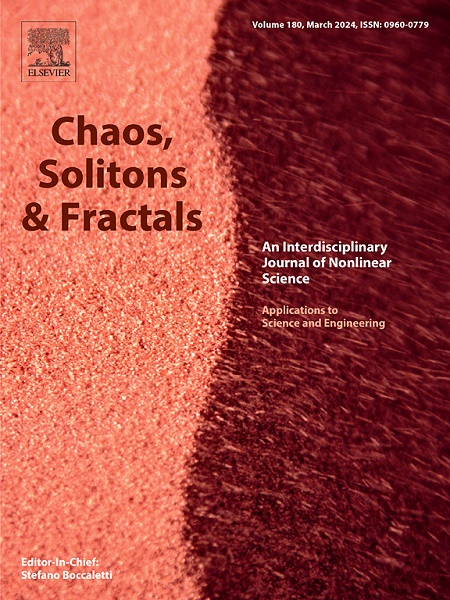具有高阶相互作用的全局耦合二部网络中的嵌合体状态
IF 5.6
1区 数学
Q1 MATHEMATICS, INTERDISCIPLINARY APPLICATIONS
引用次数: 0
摘要
我们展示了由于高阶相互作用和相位滞后参数之间的相互作用,在二部网络上的全局耦合相位振荡器中出现两种不同的稳定嵌合体和两种不同的呼吸嵌合体。我们还证明了二部网络表现出极端的多稳定状态和观察到的各种动态状态之间的相变。我们发现高阶相互作用和相位滞后参数之间的微妙平衡有利于非对称非均匀的动态状态,而两两相互作用和相位滞后参数之间的微妙平衡有利于在参数空间的大区域内形成对称均匀同步状态。此外,还发现很大程度的异质性有利于同质同步状态。我们还利用Ott-Antonsen框架从二部网络上的原始耦合相位振子离散系统推导出宏观序参量对应的低维演化方程。进一步,从宏观序参量的演化方程中解析导出了包括非同步状态在内的同相同步和非同步状态的稳定条件。本文章由计算机程序翻译,如有差异,请以英文原文为准。
Chimera states in a globally coupled bipartite network with higher-order interaction
We show the emergence of two distinct stable chimeras and two distinct breathing chimeras in a globally coupled phase oscillators on a bipartite network due to the interplay between the higher-order interaction and the phase lag parameter. We also show that the bipartite network exhibits extreme multistable states and a wide variety of phase transitions among the observed dynamical states. We find that a delicate balance between the higher-order interaction and the phase lag parameter favors asymmetric inhomogeneous dynamical states, while that between the pairwise interaction and the phase lag parameter favors symmetric homogeneous synchronized state in a large region of the parameter space. In addition, a large degree of heterogeneity also found to favor homogeneous synchronized state. We also deduce the low-dimensional evolution equations corresponding to the macroscopic order parameters from the original discrete system of coupled phase oscillators on the bipartite network using the Ott–Antonsen framework. Further, we analytically derive the stability conditions for the in-phase, and out-of-phase synchronized states including desynchronized state from the evolution equations for the macroscopic order parameters.
求助全文
通过发布文献求助,成功后即可免费获取论文全文。
去求助
来源期刊

Chaos Solitons & Fractals
物理-数学跨学科应用
CiteScore
13.20
自引率
10.30%
发文量
1087
审稿时长
9 months
期刊介绍:
Chaos, Solitons & Fractals strives to establish itself as a premier journal in the interdisciplinary realm of Nonlinear Science, Non-equilibrium, and Complex Phenomena. It welcomes submissions covering a broad spectrum of topics within this field, including dynamics, non-equilibrium processes in physics, chemistry, and geophysics, complex matter and networks, mathematical models, computational biology, applications to quantum and mesoscopic phenomena, fluctuations and random processes, self-organization, and social phenomena.
 求助内容:
求助内容: 应助结果提醒方式:
应助结果提醒方式:


